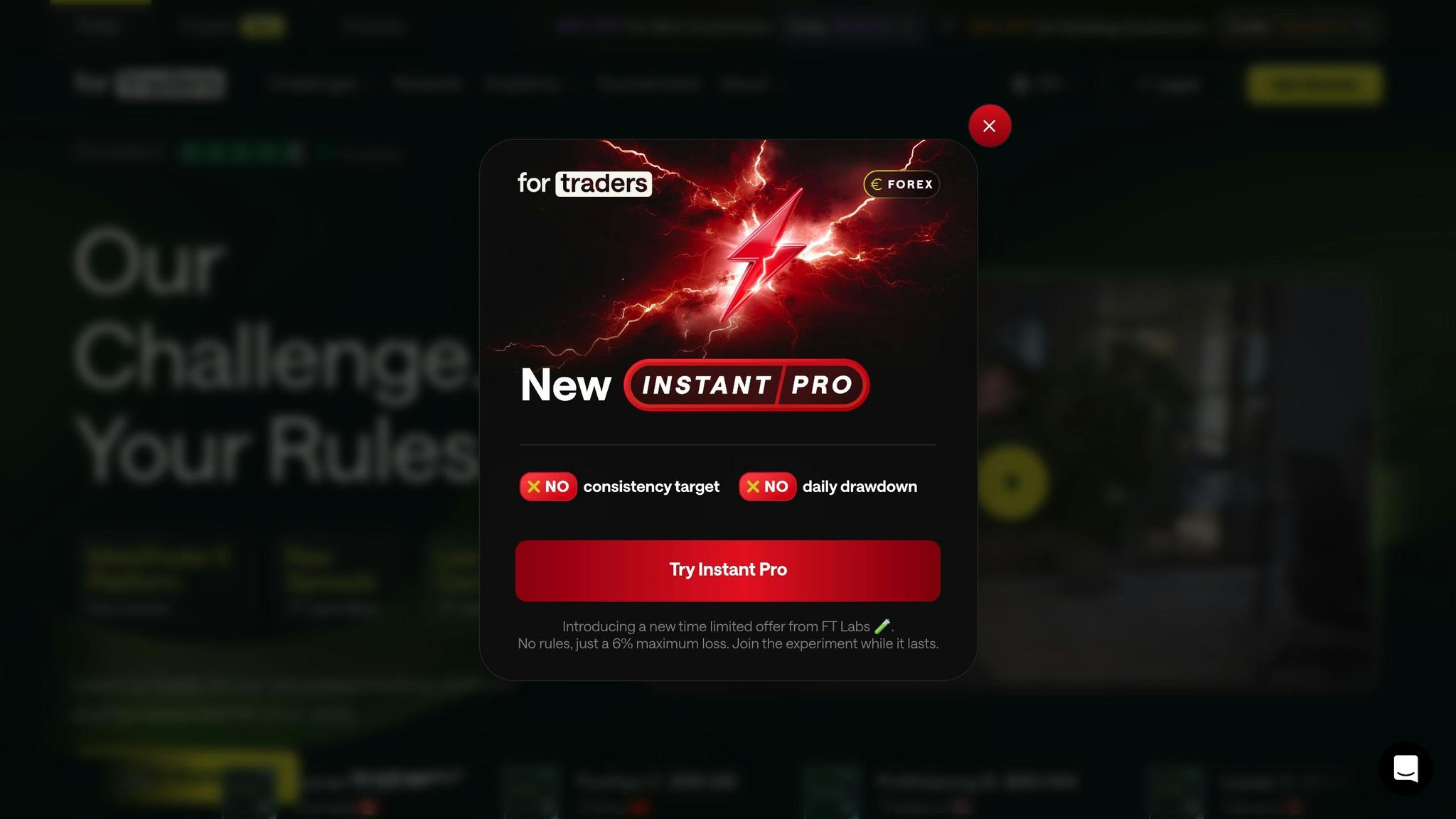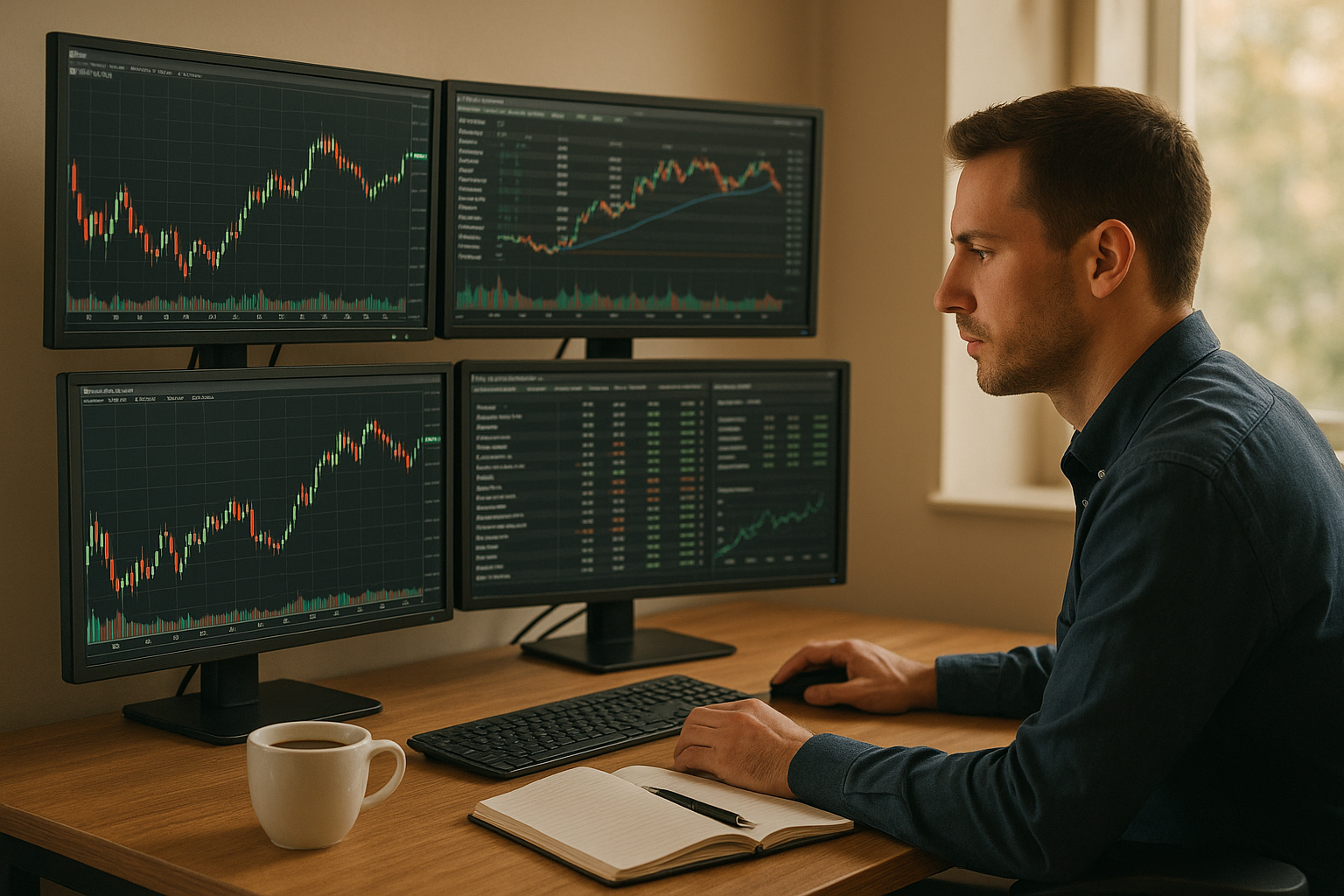In prop trading, understanding key terms is essential for success. Funded traders use a firm's capital to trade, sharing profits while adhering to strict rules. Misunderstanding terms like "drawdown" or "risk-reward ratio" can lead to costly mistakes. This guide covers critical concepts, from basic market definitions (e.g., bid/ask, spread) to risk management strategies (e.g., stop loss, position sizing). By mastering these, traders can navigate platforms, meet evaluation criteria, and maintain accounts effectively. Tools like AI coaching and educational resources further support skill-building, ensuring traders make informed decisions and stay within firm guidelines.
Guide To Make Money From Prop Firm Trading In 2025 (Full Course How to Trade)
Basic Trading Terms for New Funded Traders
Now that you know why trading terminology is important, let’s get into the essential terms you’ll need as a funded trader. These are the building blocks that will help you navigate prop trading platforms, follow trading rules, and communicate clearly with other traders. These terms also tie back to the trading environment we discussed earlier. Let’s start with the basics that define your role within a proprietary trading firm.
Core Terms in Prop Trading
A Prop Firm (Proprietary Trading Firm) is a financial institution that trades using its own capital rather than client funds. These firms often recruit skilled traders, providing them with virtual capital to trade while sharing the profits. This setup eliminates the risk of using your personal funds.
Proprietary Capital refers to the firm’s own money allocated for trading financial instruments. Once you pass an evaluation, this is the virtual capital you’ll use for trading - not your own money, so your personal funds remain secure.
To become a funded trader, you’ll need to complete a Proprietary Trading Challenge. This is a test where you trade on a simulated account and meet specific objectives to qualify for a funded account. During this phase, you’ll need to showcase your trading skills while adhering to strict guidelines.
With these foundational terms covered, let’s move on to how the mechanics of the market can influence your trading decisions.
Market Basics: Bid/Ask, Spread, and Liquidity
Understanding how the market operates is crucial for making informed trades. The Bid Price is the highest price a buyer is willing to pay for an asset at a given moment. This is the price you’ll receive when you sell. On the flip side, the Ask Price is the lowest price a seller is willing to accept, which is the price you’ll pay when you buy.
The Spread is the difference between the bid and ask prices. This difference essentially represents the cost of entering a trade. A smaller spread means lower trading costs. For example, if the EUR/USD pair has a bid of 1.0850 and an ask of 1.0852, the spread is 2 pips.
Liquidity measures how easily an asset can be bought or sold without causing a significant price change. High liquidity allows for large transactions to be executed quickly and with minimal slippage, which is essential for smooth trading.
Trading Metrics: Leverage, Margin, and Drawdown
Leverage allows you to control a larger position than your account balance would normally permit by using borrowed funds. While it can amplify profits, it also increases potential losses. For instance, with 1:100 leverage, a $1,000 account can control $100,000 in trades.
Margin is the amount of money required in your account to open and maintain a leveraged trade. Think of it as a security deposit that ensures you can cover potential losses.
Drawdown refers to the largest drop in your account balance or equity from a peak to a low point within a specific period. Prop firms monitor this closely to measure risk and enforce strict loss limits.
There are two key types of drawdown rules you’ll encounter:
- Trailing Drawdown: This adjusts upward as your account equity reaches new peaks but never falls below the initial starting balance.
- Maximum Drawdown Limit: This sets a fixed threshold for the largest allowable decline in your account balance or equity. Exceeding this limit often results in failing the challenge or losing your funded account.
Additionally, most prop firms enforce a Maximum Daily Loss rule, which caps the amount you can lose in a single trading day. This is typically expressed as a fixed dollar amount or a percentage of your starting equity. If you exceed this limit, it results in immediate failure of the challenge or termination of your funded account. Keeping a close eye on these daily losses is critical for staying within the rules.
Risk Management Terminology
Risk management is the cornerstone of successful prop trading. Without solid risk controls, even the most talented traders can quickly lose their funded accounts. Familiarizing yourself with these essential terms will help you safeguard your virtual capital and maintain steady performance over time.
Key Risk Management Terms
The Risk/Reward Ratio compares the potential profit of a trade to its potential loss. For example, a 1:2 risk/reward ratio means you're risking $1 to potentially make $2. Many successful traders aim for ratios of at least 1:2 or higher, as this allows them to stay profitable even if their win rate is below 50%.
A Stop Loss is a preset price level where you'll exit a losing trade to cap your losses. Think of it as your safety net. For instance, if you buy EUR/USD at 1.0850, you might set a stop loss at 1.0830, limiting your loss to 20 pips.
Position Sizing determines how much of your account balance you risk on each trade. Most prop firms and experienced traders suggest risking no more than 1-2% of your account per trade. For a $50,000 virtual account, this means risking $500-$1,000 per position.
Risk Per Trade is the dollar amount you're willing to lose on a single trade. This works hand in hand with your position sizing strategy and helps you calculate the right lot size based on the distance of your stop loss.
The Maximum Daily Loss caps your daily losses, typically at 5% of your starting balance. This limit is designed to prevent emotional trading after a losing streak.
Risk Management Rules are the specific guidelines prop firms enforce to protect their capital. These rules often include maximum drawdown limits, daily loss caps, and position sizing requirements. Breaking these rules can lead to immediate account termination.
With these core terms in mind, you can better understand how market dynamics and real-time valuations influence your risk exposure.
Understanding Volatility and Mark-to-Market
Volatility measures how much an asset's price moves over time. High volatility means bigger price swings, which can create both opportunities and risks. In volatile markets, you might need to scale down your position sizes to keep your risk level consistent, as stop losses are more likely to be triggered.
Implied Volatility represents the market's expectations for future price movement, often calculated from options pricing. By understanding implied volatility, you can anticipate potential market swings and adjust your risk strategy accordingly.
Mark-to-Market is the process of valuing your open positions based on current market prices. Your trading platform updates unrealized profits and losses in real time using this method. This real-time valuation is essential for monitoring drawdowns and staying within the limits set by prop firms.
Your Unrealized P&L (profit and loss) fluctuates with market prices and directly impacts your Account Equity - the sum of your account balance and open position gains or losses. For example, if your starting balance is $50,000 and you have $2,000 in unrealized losses, your equity drops to $48,000.
The Value at Risk (VaR) estimates the maximum potential loss your portfolio could face over a specific time period with a certain confidence level. While more advanced, some prop firms use VaR models to evaluate overall portfolio risk across multiple traders.
Grasping these risk management concepts isn't just about passing a prop trading challenge - it’s about building long-term habits that keep you profitable. While tools like For Traders offer AI-driven risk management features to track these metrics automatically, understanding their impact on your trading decisions is still critical.
sbb-itb-9de3b6e
Performance Metrics and Evaluation Criteria
When it comes to trading, understanding performance metrics is crucial. These metrics not only measure your profitability but also evaluate consistency and risk management - key ingredients for maintaining a funded trading account. By focusing on these metrics, traders can hone in on what truly matters for sustained success. Let’s explore the essential metrics every funded trader should master.
Key Metrics: Profit Factor, Win Rate, and Consistency
The Profit Factor is a simple yet powerful tool that compares your total profits to your total losses. It's calculated by dividing your gross profit by your gross loss. For instance, a profit factor of 1.5 means you earn $1.50 for every $1 lost. Many seasoned traders aim for a profit factor above 1.3, with elite performers often exceeding 2.0.
The Win Rate reflects the percentage of trades that are profitable out of your total trades. Interestingly, a win rate of 40%–60% can still be lucrative if paired with a strong risk/reward ratio. For example, with a $200 win and a $100 loss, you’d only need a 34% win rate to break even. This underscores why focusing on risk/reward ratios can outweigh the need for frequent wins.
Metrics like Average Win and Average Loss also provide insight into your overall trading outcomes. Meanwhile, consistency is critical - it shows how stable your returns are over time. Prop firms generally favor traders who deliver steady profits over those with erratic but occasionally high returns. Consistent monthly performance, coupled with controlled drawdowns, is often the hallmark of a funded trader.
Sharpe Ratio and Equity Curve Analysis
For a deeper dive into performance, advanced metrics like the Sharpe Ratio and equity curve analysis come into play.
The Sharpe Ratio evaluates risk-adjusted returns by comparing your excess returns (returns above a risk-free rate) to your portfolio’s volatility. For example, if you achieve 12% returns with 8% volatility and a 4% risk-free rate, your Sharpe ratio would be 1.0. This metric highlights how efficiently you’re balancing risk and reward.
Risk-Adjusted Returns are another way to assess performance. Imagine two traders both achieving 10% monthly returns - if one does so with significantly less drawdown, they are clearly managing risk more effectively.
Your Equity Curve offers a visual snapshot of your account balance over time. A smooth, upward-sloping curve suggests consistent performance, while a jagged curve with sharp drops may indicate poor risk management or high volatility. Prop firms often scrutinize equity curves for signs of instability, such as increasing drawdowns or erratic returns.
Drawdown Recovery Time is another key metric, measuring how quickly you recover from losses. Professional traders typically rebound from drawdowns within 2–4 weeks. The Calmar Ratio, which divides your annual return by your maximum drawdown, is also a valuable indicator of long-term performance sustainability. Additionally, analyzing your Monthly Return Distribution - the spread of your monthly results - can highlight whether your performance is stable or marked by wide fluctuations. Prop firms generally prefer traders with a tight range of positive returns over those with large swings between gains and losses.
Platforms like For Traders incorporate these metrics into their evaluation processes, setting benchmarks such as a 9% profit target and a 5% maximum drawdown limit. These criteria encourage traders to adopt a disciplined, risk-conscious approach.
Mastering these metrics isn’t just about passing evaluations - it’s about building a career in trading. By prioritizing tools like the Sharpe Ratio and maintaining a smooth equity curve, you can cultivate the discipline and risk management skills that separate professional traders from those who rely on luck. These are the building blocks of a sustainable and successful trading journey.
Platform-Specific Terms and Features for For Traders

For Traders introduces a variety of terms and features aimed at helping users navigate education, evaluation, and profit-sharing opportunities.
Virtual Capital Accounts and Profit Sharing
For Traders offers five tiers of simulated capital accounts: $6,000, $15,000, $25,000, $50,000, and $100,000. Each account operates with a 9% profit target and a 5% maximum drawdown, giving you clear parameters to work within.
The Profit Share model lets you keep 15% of the profits you generate across all account levels. Profits are distributed through bi-weekly payouts, ensuring you receive your earnings promptly once targets are met. Plus, the platform provides an Unlimited Time Limit, so you can focus on trading quality rather than rushing to meet deadlines. Pricing for these accounts is based on the capital allocation, starting at $46 for the $6,000 account and going up to $413 for the $100,000 account.
These features are designed to create a structured yet flexible environment where performance is tied to achievable goals.
Educational Resources and AI Coaching
The Academy includes over 12 short video courses covering everything from market fundamentals to advanced risk management techniques. These courses are available with every virtual capital plan, giving traders the knowledge they need to succeed.
The platform's AI Coach is another standout feature. It reviews your trading activity and provides personalized tips, live trade alerts, and weekly performance reports. These insights help you identify strengths and work on areas where improvement is needed.
Additionally, a collection of e-books dives into topics like market psychology, technical analysis, and platform-specific strategies. These guides are updated regularly to ensure you're equipped with the latest insights and techniques.
Together, these tools strengthen your trading skills and help you manage risk effectively.
Community Support and Advanced Trading Platforms
The Discord Community acts as a hub where traders can connect, share experiences, and get advice from both peers and For Traders staff. This supportive environment makes it easier to learn and grow.
For Traders also participates in global events like iFX Expo Cyprus, Finance Magnates Africa Summit, Wealth Expo Peru, Money Expo India, and The London Prop Trading Expo. These events provide opportunities for networking and in-person education.
On the tech side, platforms like DXTrade, TradeLocker, and cTrader offer advanced tools for professional-grade trade execution.
Other notable features include Fast Payouts, which ensure your funds are processed quickly once withdrawal requirements are met, and a Tournament option that lets you compete with other traders for additional prizes and recognition.
Conclusion: Mastering Trading Terminology for Success
Grasping trading terminology is a key step toward building a successful career in funded trading. When you truly understand terms like drawdown, profit factor, and Sharpe ratio, you’re better equipped to make informed decisions and communicate effectively with peers and support teams. This knowledge forms the bedrock of your trading journey, as outlined in earlier sections.
These terms aren’t just jargon - they’re tools to help you manage risk and execute trades with precision. Combined with a structured trading environment, they reinforce disciplined strategies in real-world scenarios, allowing you to grow without putting your own capital on the line.
What’s more, learning these concepts isn’t something you have to tackle alone. With resources like educational materials, AI-powered risk management tools, and a supportive community, you have everything you need to not only understand the terminology but also apply it effectively in your trading.
FAQs
Why is it important for new funded traders to understand trading terminology, and how does it affect their performance?
Understanding trading terminology is a must for new funded traders. It forms the basis for clear communication and helps traders make smarter decisions. When you know the key terms, it becomes easier to read market reports, analyze data, and confidently execute your strategies.
This knowledge is also crucial for managing risk and assessing performance metrics. It can help you steer clear of expensive errors. By getting a handle on the language of trading, new traders can set themselves up for success and confidently navigate the fast-moving world of prop trading.
What happens if a trader exceeds the daily loss or maximum drawdown limits set by a prop firm?
Prop firms impose strict risk management rules to safeguard both their capital and the trader's performance. These rules often include limits on daily losses and maximum drawdowns, usually set between 3% and 10% of the account balance. If a trader breaches these thresholds, the firm may respond by suspending trading temporarily, freezing the account for the day, or even permanently closing the account.
These guidelines are designed to encourage discipline, prevent large-scale losses, and ensure traders operate within the risk boundaries set for them. Adhering to these rules is a key factor in achieving consistent success in prop trading.
What are the Sharpe Ratio and Profit Factor, and how do they help evaluate a trader's performance in prop trading?
The Sharpe Ratio and Profit Factor are two important metrics that help evaluate a trader's performance and reliability in prop trading.
The Sharpe Ratio focuses on risk-adjusted returns. It tells you how much extra return a trader earns for every unit of risk they take. Simply put, a higher Sharpe Ratio signals better risk management and steadier performance.
The Profit Factor, on the other hand, compares total profits to total losses. If the Profit Factor is above 1, the strategy is in the green. The higher this number climbs, the more dependable and effective the trading approach appears.
By combining these metrics, you get a clearer picture of how well a trader balances profit generation with risk control - critical for success in the world of prop trading.


